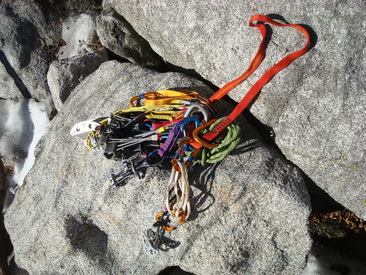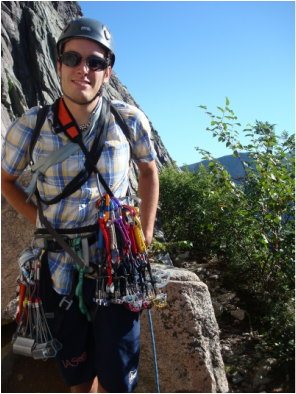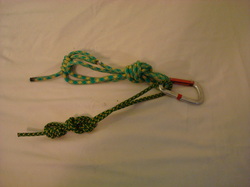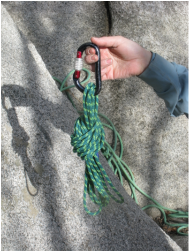A note on brands and sizing:
All major rock climbing brands manufacture quality cams and chocks. Which brand you choose is entirely a matter of personal preference. We like the action and range on Black Diamond's C4's, but prefer the Metolius Ultralight TCU for smaller pieces. If you climb in an area with shallow cracks, you might prefer the Metolius Power Cam, or perhaps the Wild Country Friends. Try them all out, find what works for you, and go with it. It does make sense to stick to a single company for each range (small, regular, large), since the color-coordinated slings are helpful in selecting the correct piece. Also, the numbering systems are different for each company, so it can be helpful to know the conversions. This chart shows the size comparisons between the main brands.
All major rock climbing brands manufacture quality cams and chocks. Which brand you choose is entirely a matter of personal preference. We like the action and range on Black Diamond's C4's, but prefer the Metolius Ultralight TCU for smaller pieces. If you climb in an area with shallow cracks, you might prefer the Metolius Power Cam, or perhaps the Wild Country Friends. Try them all out, find what works for you, and go with it. It does make sense to stick to a single company for each range (small, regular, large), since the color-coordinated slings are helpful in selecting the correct piece. Also, the numbering systems are different for each company, so it can be helpful to know the conversions. This chart shows the size comparisons between the main brands.
A Basic Rack
The rack described here is the bare minimum that you will need to climb short trad routes with varying crack sizes. Don't jump on a big multi-pitch with just this, or you may run out of gear and have to run it out! A very basic rack consists of the following:
Passive protection:
A set of 10 wedge nuts or hex nuts ($120)
one keylock carabiner to carry them ($7)
Active protection:
5 cams, BD sizes #0.4, #0.5, #0.75, #1, #2 or equivalent ($250-300)
Carabiners for each ($30)
Other gear:
10 carabiners ($60)
Passive protection:
A set of 10 wedge nuts or hex nuts ($120)
one keylock carabiner to carry them ($7)
Active protection:
5 cams, BD sizes #0.4, #0.5, #0.75, #1, #2 or equivalent ($250-300)
Carabiners for each ($30)
Other gear:
- 5 alpine draws
10 carabiners ($60)
- 4 long sport draws ($50)
- 4 locking carabiners ($40)
- one 25 foot cordelette ($10)
- one 48 inch runner ($8)
- one nut tool ($10)
Once you have this gear, you can start doubling up on sizes that you find yourself needing. We immediately got doubles on #.5, #1 and #2 cams, since we most often ran out of these. Consider getting a set of nuts and hexes, since each has their merits and optimal placements. You can also start getting more specialized gear, like tri-cams. We recommend getting a red and a pink tri-cam. They are really useful in horizontal cracks, are really light and are cheaper than cams. Also, get a gear sling to carry it all. It is more comfortable than a runner and you can move it to your front or back to get it out of your way.
Our Standard Rack Now

Part of our current rack.
We have a fair amount of gear now, but we don't bring it all on a climb. Our standard, go-anywhere rack for normal, varied routes is the following:
Lots of people prefer to use small cams, such as the Black Diamond C3's, instead of nuts for small placements, but we find nuts to be lighter and often more secure. Nuts are also a lot cheaper than cams. Our small cams are mainly for horizontal placements. Also, we don't carry all this gear individually. Each of us takes a cordelette and two locking carabiners, and our own nut tool, as long as we are swinging leads. This cuts weight and transition time.
Everyone has their own preferences, so figure out what works for you and do that. One friend of ours carries ten or twelve alpine draws, then racks his cams 4 to a biner. Find a comfortable, easy system and stick to it.
- BD cams #0.3, #0.4, #0.5 (2), #0.75, #1(2), #2(2)
- Metolius Ultralight Cam #0
- Wild Country Friend #0
- 2 large Rock Empire cams (BD #3 and #4 equivalent)
- CAMP red tricam
- 3 sets of four nuts and hexes on separate biners (Small, Medium, and Large sets)
- 2 25-foot cordelettes
- 2 48-inch runners
- 7 24-inch alpine draws
- 1 48-inch alpine draw
- 5 locking carabiners
- 4 carabiners
- nut tool
- gear sling
- 2 short loops of cordelette (10-20") with carabiners biners for making a rope ascension system in a pinch (see the Kleimheist and Prussik pages as well as Ascending a Rope). Photo below.
Lots of people prefer to use small cams, such as the Black Diamond C3's, instead of nuts for small placements, but we find nuts to be lighter and often more secure. Nuts are also a lot cheaper than cams. Our small cams are mainly for horizontal placements. Also, we don't carry all this gear individually. Each of us takes a cordelette and two locking carabiners, and our own nut tool, as long as we are swinging leads. This cuts weight and transition time.
Everyone has their own preferences, so figure out what works for you and do that. One friend of ours carries ten or twelve alpine draws, then racks his cams 4 to a biner. Find a comfortable, easy system and stick to it.
Buying Trad Gear
You can often find great deals on gear at retail stores around the country. As companies create new designs, their older gear will go on sale. For example, with the new Petzl GriGri just hitting the market, you can now find the original GriGri for half price in places (a great deal on a $100 belay device!). Shop in the late winter and late fall for gear. Also, if you are really on a budget, you can get creative with your gear: you can make runners with tubular webbing, and disassemble your sport draws to make alpine draws. Definitely look around: we found a store going under that sold us some really bizarre-sized gear for pennies, including the huge tricam in the picture above.
There are also a bunch of websites that offer great deals on gear. GearExpress.com, MountainGear.com, Backcountry.com and many others have stellar discounts on pro and other gear. We own two cams from Rock Empire. This gear company sells cams for up to $20 less than the major brands. To be honest, they are not quite as nice to use as the Black Diamond or Metolius cams, but they are really cheap. We decided to fill out our larger range with these cams to save money, and as of yet we don't regret it. However, if you have the dough, spend it on nicer gear. You will be really happy in the future. |
|



